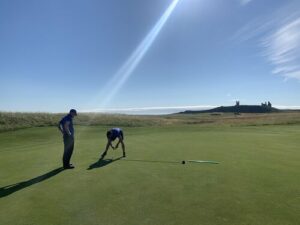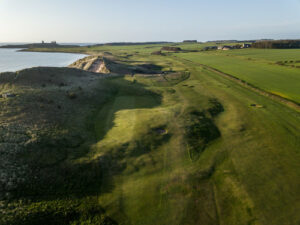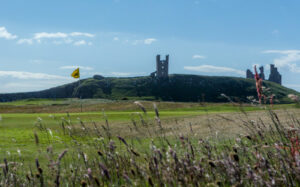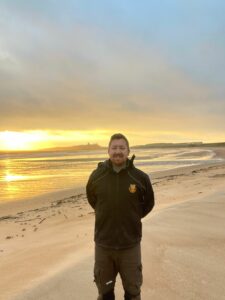Meet the head greenkeeper, and golf club owner: Stuart Imeson
Related Articles
Stuart, the co-owner of Dunstanburgh Castle Golf Course in Northumberland, talks about this dual role, how the current cost of living crisis is affecting the club and the products he uses to maintain and improve his golf course.
When Stuart Imeson did his work experience aged 14 at Dunstanburgh Castle Golf Course he could never have imagined he’d be head greenkeeper at 18 and co-owner by the age of 31. He tells us his unique story, all about his plans for the future and why winter is Dunstanburgh’s time to shine.
You started in the industry as an apprentice greenkeeper and now co-own Dunstanburgh Castle Golf Course. Can you tell us about that journey?
I left school at 15 and got an apprenticeship here at Dunstanburgh. I’d done work experience here when I was 14 and been a member since I was eight, so I knew a bit about the course and it seemed logical at the time to go into greenkeeping. A chain of events happened that meant I became acting head greenkeeper around the age of 18 and was still in that position until I got promoted to golf course manager about five years ago. I’m 31 now.
I’m the type of person who, if a challenge is put in front of me, I will try everything to solve it and not be beaten. The ability to persevere and solve problems served me quite well when I was younger, and it still does. Historically, I think greenkeepers and golf professionals have those skills, and tend to be quite thick-skinned and trust my instincts too. I became golf course manager at 25 and that role gave me a bit more freedom with planning, spending and recruitment. I learned how to manage the business through the pandemic and various other challenges and the next logical step seemed to be for me to get some kind of security for myself within the business. I figure that I’m in one of the most fortunate positions a greenkeeper at heart could ever be in now I have a percentage stake in my own golf course, but it’s been quite a hard process to get here. I have had a lot of support from the former owner and was able to learn a lot about the business from him. I officially became a co-owner in May and I’m really excited about what the next few years have in store.
What was the most surprising aspect of the transition from employee to co-owner for you? How different is your average day now?
The biggest change has been the respect people have for me now. The difference was colossal as soon as I stopped being the manager and became an owner and more people started to take me seriously. It’s made me think about staff wellbeing and how my staff are treated in general.
My average day is still full on but now I’m able to plan a bit more I think the workload is getting easier to manage. I’m able to prioritise now because I know I need to delegate and manage my time better. I’ve taken myself out of the deep end a bit and I’ve got a bit more control over what I do.
Tell us about the course and your future plans for it.
Dunstanburgh is a unique place, it’s a links golf course set in an area of outstanding natural beauty and it has Sites of Special Scientific Interest (SSSI), preservation orders and biodiversity action plans. We’ve got a nature reserve on one side and a 13th century castle at the other end of the course. In between that there are 18 holes of good links golf with a bay and a beach. It’s just a great place and I think if it wasn’t a golf course it would be impossible to put a price on this land.
The course has been coming into its own over the last few years, rising up the rankings. It’s been recognised in the Golf World Top 100: Best Golf Courses for £60 and under, the Top 100 England golf courses and we were shortlisted for the Top 100 Links Courses. It’s starting to become one of Northumberland’s finest golf courses. Northumberland isn’t like Lothian or Fife yet but it’s an up-and-coming area for golf and it’s much cheaper to come and play golf here.
When I was golf course manager we put some really good foundations in place on the course, for instance we did some bunker renovations, which we hope will last for the next decade. It’ll be a case of evaluating the course constantly and if it’s not up to scratch we’ll make changes; it’s an on-going cycle. We’re now going through things on the business side and evaluating certain aspects and making sure we’re improving and developing all the time. We haven’t got any plans to slow down or stop evolving, we want to keep raising the bar all the time. We started as a budget golf club, and we’re at the top end of good budget golf clubs now. Our plan is to break into the next level and if we want to do that we can’t sit still. I understand that change can be daunting but it’s exciting too.
We’re currently making some improvements to the clubhouse and we’re looking into opening some practice areas, which have never been on the agenda in the past because of budgets and so on. I’ve got a great team around me who are really buying into the vision for the future of the golf course, which is really important to me and to my family too.
How is the current economic situation affecting you and how do you plan to combat soaring costs?
Obviously when you’re in the hot seat making financial decisions for a business you have to be cautious and energy costs are one of the biggest outgoings, but you still have to be confident in the way you approach things. Once you start cutting everything back you start going backwards, although we’re also aware of the dangers of being too ambitious in this climate. We could cut down on heating in the clubhouse but then it would be less comfortable for members and they wouldn’t want to stay there, so it would defeat the object. We’re being tactical and have made provision for this kind of thing but our focus will be keeping standards high. There are going to be some tough times and golf will suffer because it’s a luxury, but we are being positive and taking things month by month and not resting on our laurels. I think the more closely golf clubs work together during this time the better it will be for us all. It’s quite daunting coming into the winter knowing energy costs are so high but we’re lucky at Dunstanburgh because we’re a links course and stay nice and dry in winter, so that’s our time to shine. We take on a good number of winter members and work hard to sell them the idea of becoming full members.
Has the course been affected by extreme weather this year and are you concerned about the effect of climate change on the industry?
We had a baking hot summer and we’re just about to go into storm season [we spoke in early October 2022] but you just have to take it as it comes. We had quite a lot of damage on the fairways over the summer and we’re in the process of overseeding at the moment. We’ve created a larger budget for the course over the last few seasons so we can plan ahead and spray things like wetting agents and seaweed so that the damage isn’t as bad at the end of the summer. 2018 was a really difficult year for us and we lost a good 30 to 40 percent of the grass on our fairways and some areas haven’t quite recovered. It taught us to invest in wetting agents, which pays for itself in the end. It was a great summer for people playing golf, though!
There’s clearly a global climate change crisis that’s key to the turbulent weather we’ve been getting, which is obviously going to become the new normal. Greenkeepers’ jobs are difficult enough but these changes are going to make them more difficult. All golf clubs should make a conscious effort to reduce their impact on the climate where they can, whether it be switching to battery-powered machines, tree-planting or increasing flora and fauna out on the course.
What has been your proudest achievement as a co-owner so far?
I’m very proud of what we’ve done at Dunstanburgh as a whole. When I took over as head greenkeeper it was known as a bit of a dust bowl and wasn’t very well known as a golf course. What we’ve built to this day, and the recognition we’ve had from the Faldo Series and the PGA, has made us all very proud. It’s all part of one big journey involving everyone who’s ever worked here, especially in the past five or six years. During that time we’ve elevated a long way. There aren’t enough ‘thank yous’ under the sun to thank everyone who’s been part of it. I hope we keep going in the same direction and make the same impact in the next five or six years, and I think a lot of that will be down to how positive I can be about the future. My mind’s set on how I want to drive things forward.
Personally, I won a couple of awards and probably jumped around a lot at the time! I won BIGGA Greenkeeping Project of the Year in 2019 because I had a good team around me and they helped me achieve what I needed to achieve. I also won BIGGA Young Greenkeeper of the Year in 2015, and it was judged partly on the maintenance of the course here, so again it was a team effort. I didn’t cut everything or rake every bunker; it was the team around me that did it. I’ve been very fortunate so far.
What’s your relationship with Origin Amenity Solutions and how do they support you?
Ninety percent of the products we buy for course maintenance come from Origin Amenity Solutions, from fertiliser to seeds to wetting agents, sand and top dressing. I have worked with Rigby Taylor for years and have a great relationship with them. Now they are part of the Origin Amenity Solutions group, and they’ve supported me personally through a lot of ups and downs. Our machinery shed burnt down in 2018, the same year as the very hot summer. Origin helped us in every way that year, from helping us procure new machinery to putting us in touch with useful contacts.
They know the industry inside out and can advise on almost anything. Having a relationship like the one we’ve got with Origin is so important, especially when things go wrong. We know we can ring them for advice on a wide range of issues whenever we need to and they have made the effort to understand us here and get to know my staff, not just me.
Which products do you rely on and how have they made a difference to the course?
For the greens we do monthly applications from March through to August using HydroPro2 wetting agent, tanked mixed the liquid supplements Revive and Root, from the Nutri-Link range. The nutritional inputs, using a combination of Microflow CSX 26.0.0 and 4.3.16 tank mixed with the organic cocktail Microdyne, have provided superb benefits in terms of controlled growth and colour. These liquid applications have been followed by a granular application of Autumn Green Bio 3.0.12
For tees, we have undertaken monthly applications of Breaker Sport wetting agent Breaker tank mixed with Seaquest seaweed. Granular applications of Convert Gold 21.5.11 have also been applied.
Our fairways also received initial monthly applications of Breaker Sport wetting agent, followed by Breaker Fairway No.3. Our granular applications included Apex Organic 5.2.4.
A combination of seed ‘R’ range seed mixtures are used around the course. R117 fine fescue blend has great high shoot density, is both red thread and salt tolerant. The ‘R’ mixes of R116 and R8 fine fescue and ultra-fine dwarf rye provides fast establishment with excellent cleanness of cut and superb recovery under testing conditions. We also include the ultra-fine dwarf perennial rye mix R9.
We’ve been using many of these products for years and they’ve made a big difference, especially the wetting agents. Consistency is very important when it comes to maintaining high standards on a course and we’ve been getting great results with these ranges.
What advice would you give to anyone wanting to move from greenkeeper to owner?
It’s quite an unusual thing to do at the moment but I’d say being positive and having the attitude that you can and will succeed will help. I’ve never been one to see a barrier and think I can’t get past it. Greenkeepers are some of the best problem solvers out there and that makes all the difference when trying to achieve something new. Greenkeeping can be quite a remote job and you can be out there on your own quite a lot so you have to think on your feet. I think that’s stood me in good stead to be in the position I’m in.































